Microneedle Drug Delivery Systems Market Size
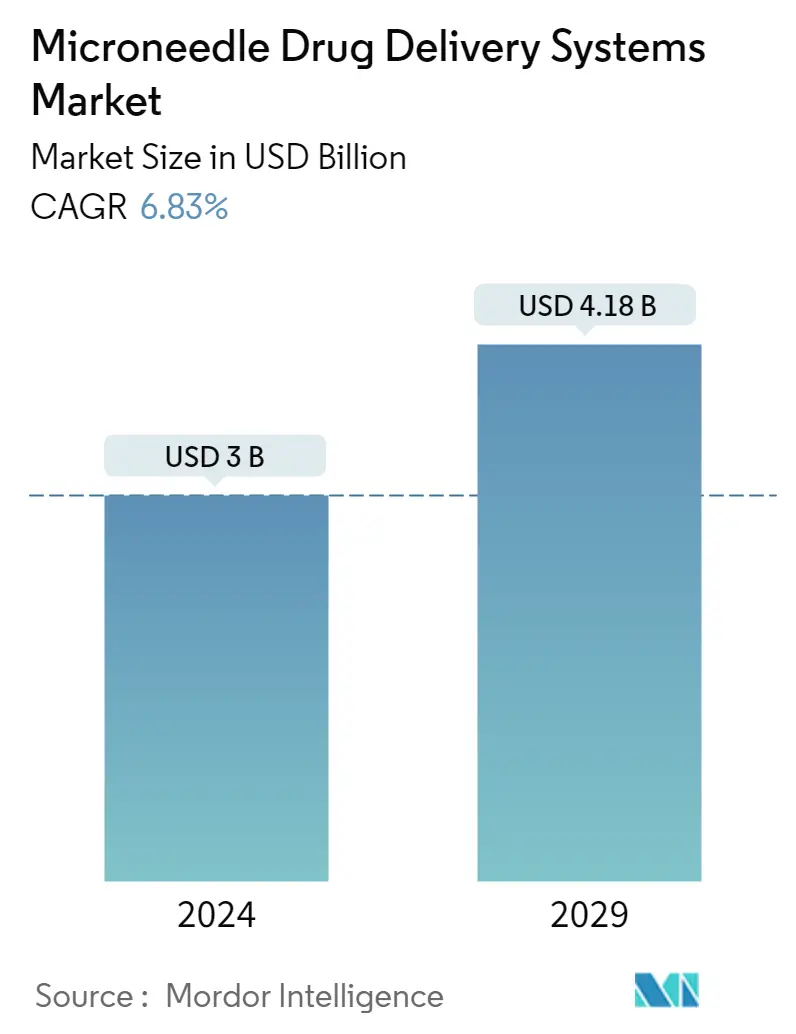
| Study Period | 2019 - 2029 |
| Market Size (2024) | USD 3.00 Billion |
| Market Size (2029) | USD 4.18 Billion |
| CAGR (2024 - 2029) | 6.83 % |
| Fastest Growing Market | Asia-Pacific |
| Largest Market | North America |
Major Players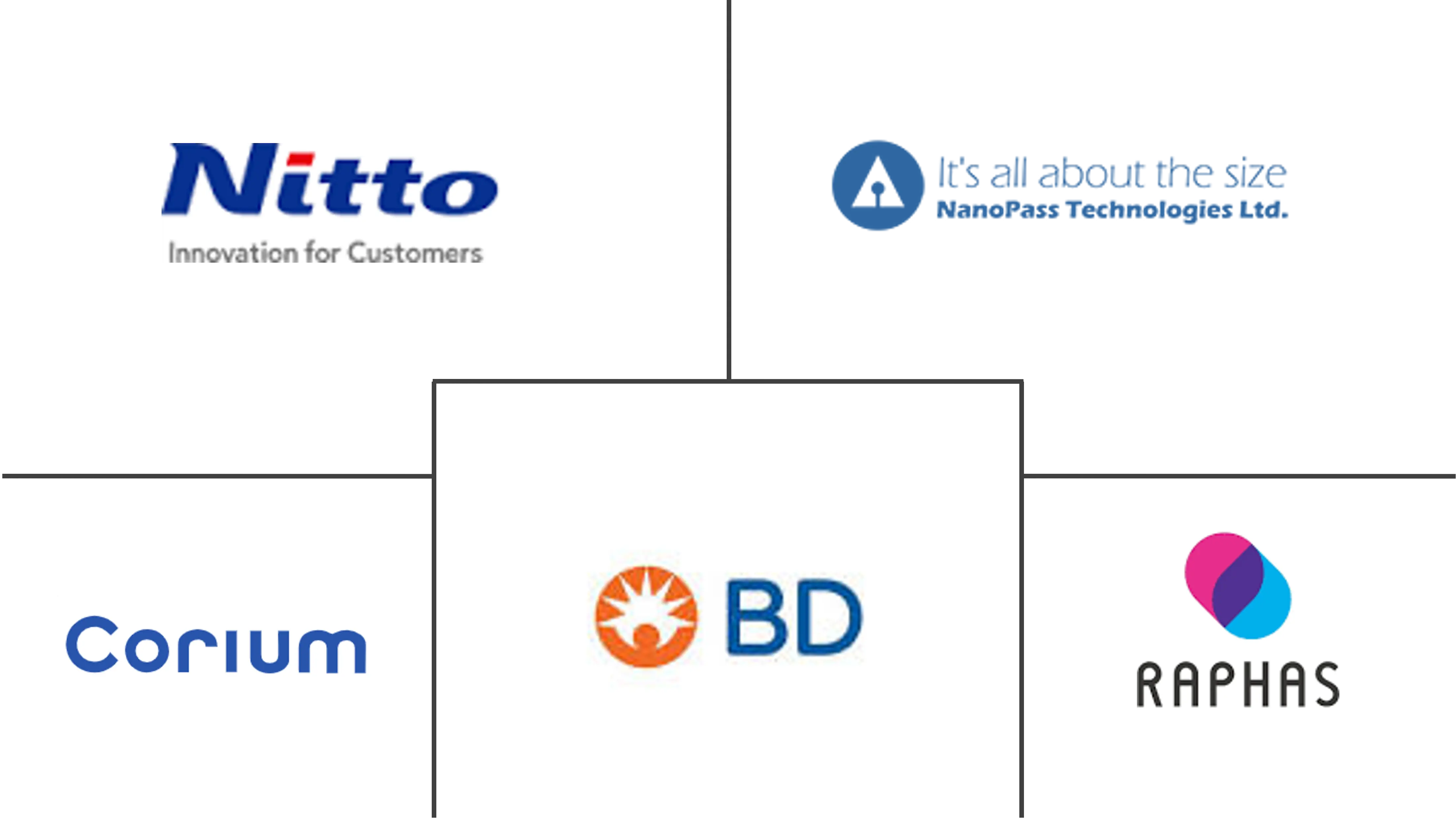
*Disclaimer: Major Players sorted in no particular order |
Microneedle Drug Delivery Systems Market Analysis
The Microneedle Drug Delivery Systems Market size is estimated at USD 3 billion in 2024, and is expected to reach USD 4.18 billion by 2029, growing at a CAGR of 6.83% during the forecast period (2024-2029).
COVID-19 impacted the growth of the microneedle drug delivery market. The lockdown measures imposed by the government and the shutdown of hospitals and clinics resulted in disrupted services for patients suffering from chronic and lifestyle-related diseases. The rising COVID-19 cases increased the focus of companies and institutions to develop fingertip-sized skin patches for the delivery of drugs during the pandemic. For instance, according to an article published by ACS, in May 2020, the researchers at the University of Pittsburgh Medical Center and the University of Pittsburgh tried to develop a microneedle array (MNA), a fingertip-sized patch with 400 microscopic needles that inject spiked protein fragments into the skin, where an immune response is most potent. Thus, the use of microneedles for COVID-19 vaccination impacted the market's growth during the pandemic. Moreover, the focus of the companies is shifting toward developing microneedle patches and drug delivery systems. For instance, in October 2021, Tapemark partnered with 10X Technology to commercialize MicroDerm, which uses microneedle technology to deliver a wide range of drugs via transdermal patches. The patch's tiny microneedles penetrate the skin just deep enough for the medication to reach the bloodstream without causing discomfort or inconvenience as compared to hypodermic needles. Thus, such developments are expected to increase the market's growth over the forecast period.
The growth of the market is being driven by things like the growing number of chronic diseases and lifestyle-related disorders, more research on painless drug delivery, advances in technology, and the growing demand for a safer alternative to traditional hypodermic injections.
The increasing prevalence and burden of chronic diseases around the world are driving the demand for effective and advanced drug delivery systems, which is the key factor driving market growth. For instance, according to the BHF England Factsheet, published in January 2022, about 6.4 million people were living with cardiovascular diseases in England in 2021. Also, as per the 2022 statistics published by the BHF, around 7.4 million people will be living with heart and circulatory diseases in the United Kingdom in 2021. So, the high number of people with cardiovascular diseases drives up the demand for controlled or slow drug release, which is expected to drive market growth over the next few years.
Additionally, according to 2022 statistics published by the IDF, about 537 million people worldwide were suffering from diabetes in 2021, and this number is projected to reach 643 million and 784 million by 2030 and 2045, respectively. Thus, the expected increase in the diabetic population increases the demand for microneedle technology to deliver insulin through the stratum corneum of the skin in a minimally invasive and painless way. This is anticipated to augment market growth over the forecast period.
Furthermore, the rising research studies related to microneedle drug delivery are expected to raise its adoption during drug delivery, vaccine formation, or the treatment of various diseases through microneedle systems. This is also contributing to market growth. For instance, according to an article published by the Journal of Pharmaceutical Innovation in October 2021, it has been observed that microelectromechanical system (MEMS)-based microneedles are an innovative way of drug delivery that increases the permeability of the skin. It creates microscopic pores within the skin, allowing for passive drug diffusion and dermal microcirculation. This phenomenon aids in the effective permeation of drugs. As a result, the benefits of microneedles are expected to drive market growth over the forecast period.
Moreover, the rising company activities in developing microneedle products and increasing product launches are also contributing to the market growth. For example, in January 2022, Zosano Pharma announced that clinical data showed that a trivalent influenza vaccine made for its transdermal microneedle system was just as effective as a higher dose of the same vaccine injected into the muscle.
Therefore, owing to the aforementioned factors, such as the high burden of chronic and lifestyle-related disorders and the increasing adoption of microneedle drug delivery systems, the studied market is expected to grow over the forecast period. However, the limited number of approved products, as well as the complications or risks associated with microneedles, are likely to stymie market growth over the forecast period.
Microneedle Drug Delivery Systems Market Trends
This section covers the major market trends shaping the Microneedle Drug Delivery Systems Market according to our research experts:
Vaccine Delivery Segment is Expected to Hold a Significant Market Share Over the Forecast Period
The vaccine delivery segment is expected to witness significant growth in the microneedle drug delivery market over the forecast period owing to factors such as the rising prevalence of influenza and viral infections as well as the key players focusing on research and development of microneedle vaccines. For instance, according to the 2022 report of the National Center for Disease Control (NCDC) of India, as of October 31, 2022, about 12,563 cases of seasonal influenza (H1N1) were reported in India, compared to just 778 cases in overall 2021. This is also expected to fuel demand for microneedle vaccines, thereby bolstering segment growth. Also, according to an article published in December 2022, yearly influenza epidemics can affect all populations, but children younger than the age of 2, adults older than 65, as well as people with chronic medical conditions or weakened immune systems, bear the highest risk of complications. The annual attack rate is estimated at 5-10% in adults and 20-30% in children. Thus, the increasing burden of influenza raises the demand for effective influenza vaccines, which in turn is anticipated to fuel segment growth over the forecast period.
Additionally, as per an article published in Micromachines in April 2021, it has been observed that the microneedle vaccinations provide a significant immune response against a variety of viral and bacterial infections, as the needles ranging from 50 to 900 m in length can efficiently deliver the vaccine to the epidermis and the dermis region, which contain many Langerhans and dendritic cells. In addition, as per the same source, the use of microneedles made from sustained-release polymers or integrated with microparticles or nanoparticles may eliminate the requirement for multiple vaccinations. Because microneedles drug delivery systems have so many benefits, they are likely to be used to make vaccines against viral and bacterial infections. This is expected to help the segment grow.
Furthermore, the rising company's focus on adopting various business strategies such as mergers, collaboration, and others, as well as the increasing number of vaccine launches, are also expected to boost segment growth over the forecast period. For instance, in October 2021, Vaxess Technologies, a biotechnology startup developing the MIMIX sustained-release intradermal microneedle patch, opened its 3,600-square-foot pilot GMP (good manufacturing practices) manufacturing facility. Also, in June 2021, Microdermics, Inc. merged with Novateur Ventures, a well-known global life sciences advisory firm, in order to provide strategic advice and lead the transaction process for the commercialization of a new microneedle flu vaccine and biosensing platform.
Because of things like the high number of people with infectious diseases, the growing use of microneedles in making vaccines, and the increasing number of company activities and vaccine launches, the studied segment is expected to grow over the forecast period.
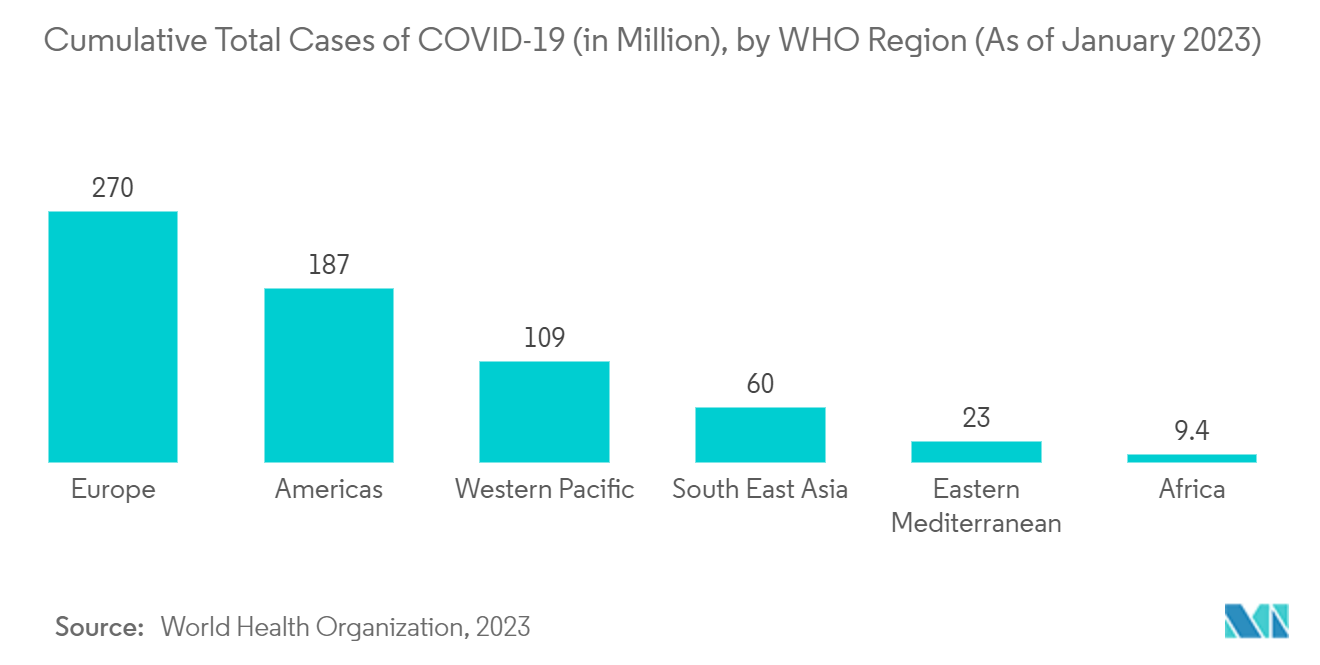
North America is Expected to Have the Significant Market Share Over the Forecast Period
North America is expected to witness significant growth in the microneedle drug delivery systems market over the forecast period owing to factors such as the rising prevalence of chronic diseases, skin diseases, and infectious diseases; growing technological advancement in drug delivery systems; increasing adoption of highly advanced techniques and systems in the fabrication of microneedles; and the technological advancements made in microneedle drug delivery. People are also very aware that new microneedle drug delivery systems are on the market, which helps to explain why the market is growing so quickly in the region.
The rising burden of chronic diseases is the key factor driving the demand for microneedle drug delivery systems in the region. For instance, as per the 2022 statistics published by the National Brain Tumor Society, approximately 88,970 people were expected to be diagnosed with a primary brain tumor in the United States in 2022. In addition, as per the same source, an estimated 4,170 new cases of childhood brain tumors and 12,072 new cases of adolescent and young adult brain tumors were expected to be diagnosed in 2022. Furthermore, according to AHA statistics, more than 130 million adults in the United States are expected to have some form of heart disease by June 2021. So, the high number of people with heart disease and brain tumors is likely to increase the demand for microneedle drug delivery technology, which is expected to help the market grow in the region.
Additionally, according to an article published by the Center for Health Protection, in December 2022, the rate of hospitalization for flu in the United States was 16.6 per 100,000 people between October 1, 2022, and November 26, 2022. Hence, the high number of flu cases in the population increases the demand for microneedles coated with whole, inactivated influenza viruses that deliver the antigen cargo through the tight stratum corneum skin barrier, causing protective immunity and driving the growth of the market.
Furthermore, the rising company's focus on adopting various strategic initiatives, such as collaboration, partnerships, agreements, and others, is expected to fuel market growth in the region over the forecast period. For instance, in December 2021, Wrinkles Schminkles launched self-dissolving microneedle patches with 1800 microneedles that use innovative technology to directly deliver active ingredients deep into the skin. The patch smooths out tiny lines and wrinkles by self-dissolving and releasing the active ingredients into the dermal layers of the skin. Also, PharmaTher and TSRL signed a co-development agreement in June 2021 to work together on making a microneedle array patch.
Thus, the studied market is expected to grow over the next few years because of things like the high number of people with chronic and infectious diseases and the growing number of company activities and new product launches.
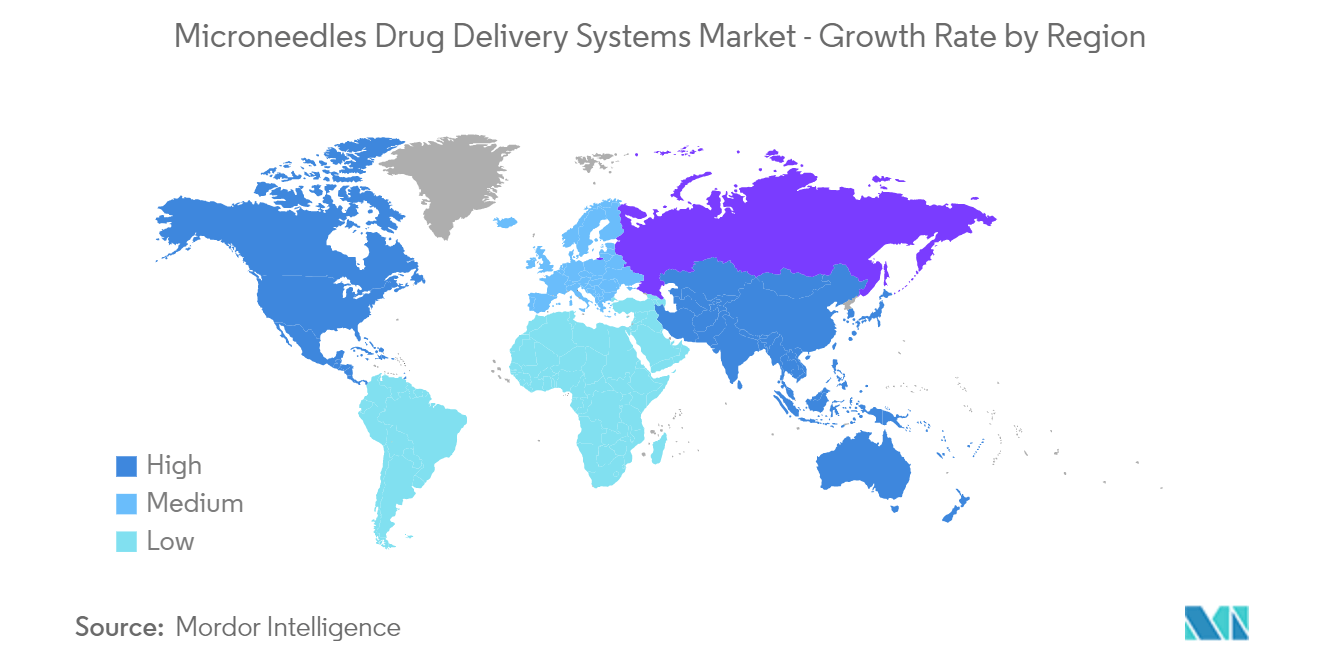
Microneedle Drug Delivery Systems Industry Overview
The microneedle drug delivery systems market is fragmented and competitive and consists of several major players. In terms of market share, a few of the major players are currently dominating the market. Some of the companies currently dominating the market are 3M Company, Becton, Dickinson and Company, Raphas Co. Ltd, Nanopass Technologies, Corium Inc., Nitto Denko Corporation, Zealand Pharma AS, nanoBioSciences LLC, Micropoint Technologies, LTS Lohmann Therapie-Systeme AG, and others.
Microneedle Drug Delivery Systems Market Leaders
-
Becton, Dickinson and Company
-
Raphas Co. Ltd.
-
Nanopass Technologies
-
Corium Inc.
-
Nitto Denko Corporation
*Disclaimer: Major Players sorted in no particular order
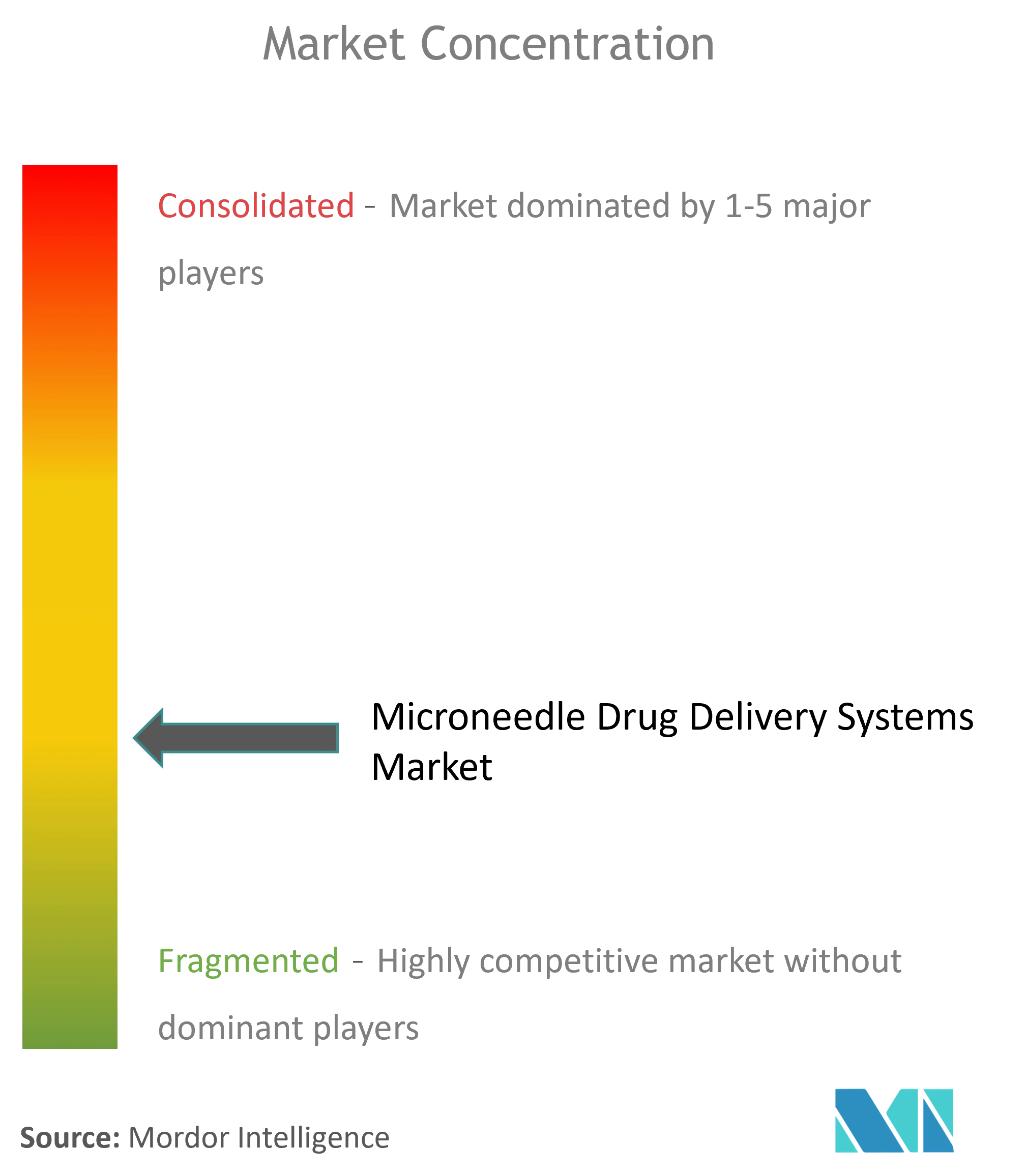
Microneedle Drug Delivery Systems Market News
- November 2022: CGBio, a South Korean healthcare provider, launched a skin trouble care patch, CGDew Derma Regen, in its microneedle pipeline. These microneedle patches are made from a range of materials, such as silicon, titanium, stainless steel, and polymers, to improve the diffusivity of medications to the stratum corneum by forming pores on the skin that are smaller than a micron.
- October 2022: Emergex Vaccines Holding Limited acquired the assets of Zosano Pharma Corporation. The assets include intellectual property, license agreements, manufacturing equipment, Zosano's proprietary microneedle array patch (MAP) intradermal drug delivery system, solid-coated microneedle array patch technology, methods for formulation and microneedle coating, and specialized equipment.
Microneedle Drug Delivery Systems Market Report - Table of Contents
1. INTRODUCTION
- 1.1 Study Assumptions and Market Definition
- 1.2 Scope of the Study
2. RESEARCH METHODOLOGY
3. EXECUTIVE SUMMARY
4. MARKET DYNAMICS
- 4.1 Market Overview
-
4.2 Market Drivers
- 4.2.1 Increasing Prevalence of Chronic Diseases and Lifestyle-related Disorders
- 4.2.2 Increasing Research on Painless Drug Delivery and Technological Advancement
- 4.2.3 Increasing Demand for a Safer Substitute to Conventional Hypodermic Injections
-
4.3 Market Restraints
- 4.3.1 Limited Number of Approved Products and Complications/Risks Associated with Microneedles
-
4.4 Porter's Five Forces Analysis
- 4.4.1 Threat of New Entrants
- 4.4.2 Bargaining Power of Buyers/Consumers
- 4.4.3 Bargaining Power of Suppliers
- 4.4.4 Threat of Substitute Products
- 4.4.5 Intensity of Competitive Rivalry
5. MARKET SEGMENTATION (Market Size by Value - USD million)
-
5.1 Product Type
- 5.1.1 Solid
- 5.1.2 Hollow
- 5.1.3 Coated
- 5.1.4 Dissolvable
-
5.2 Application
- 5.2.1 Drug Delivery
- 5.2.2 Vaccine Delivery
- 5.2.3 Dermatology
- 5.2.4 Other Applications
-
5.3 Geography
- 5.3.1 North America
- 5.3.1.1 United States
- 5.3.1.2 Canada
- 5.3.1.3 Mexico
- 5.3.2 Europe
- 5.3.2.1 Germany
- 5.3.2.2 United Kingdom
- 5.3.2.3 France
- 5.3.2.4 Italy
- 5.3.2.5 Spain
- 5.3.2.6 Rest of Europe
- 5.3.3 Asia-Pacific
- 5.3.3.1 China
- 5.3.3.2 Japan
- 5.3.3.3 India
- 5.3.3.4 Australia
- 5.3.3.5 South Korea
- 5.3.3.6 Rest of Asia-Pacific
- 5.3.4 Rest of the World
6. COMPETITIVE LANDSCAPE
-
6.1 Company Profiles
- 6.1.1 Candela Corporation
- 6.1.2 Becton, Dickinson and Company
- 6.1.3 Raphas Co. Ltd.
- 6.1.4 Nanopass Technologies
- 6.1.5 Corium Inc.
- 6.1.6 Nitto Denko Corporation
- 6.1.7 Dermaroller GmbH
- 6.1.8 nanoBioSciences LLC
- 6.1.9 Micropoint Technologies
- 6.1.10 LTS Lohmann Therapie-Systeme AG
- *List Not Exhaustive
7. MARKET OPPORTUNITIES AND FUTURE TRENDS
** Subject To AvailablityMicroneedle Drug Delivery Systems Industry Segmentation
As per the scope of this report, a microneedle drug delivery system is a transdermal drug delivery system used to administer drugs and vaccines in a non-invasive, painless manner. Microneedles create temporary, micron-sized pores on the skin through which drugs and vaccines are delivered. The microneedle drug delivery systems market is segmented by product type (solid, hollow, coated, and dissolvable), application (drug delivery, vaccine delivery, dermatology, and other applications), and geography (North America, Europe, Asia-Pacific, and the Rest of the World). The report offers the value (in USD million) for the above segments.
| Product Type | Solid | |
| Hollow | ||
| Coated | ||
| Dissolvable | ||
| Application | Drug Delivery | |
| Vaccine Delivery | ||
| Dermatology | ||
| Other Applications | ||
| Geography | North America | United States |
| Canada | ||
| Mexico | ||
| Geography | Europe | Germany |
| United Kingdom | ||
| France | ||
| Italy | ||
| Spain | ||
| Rest of Europe | ||
| Geography | Asia-Pacific | China |
| Japan | ||
| India | ||
| Australia | ||
| South Korea | ||
| Rest of Asia-Pacific | ||
| Geography | Rest of the World |
Microneedle Drug Delivery Systems Market Research FAQs
How big is the Microneedle Drug Delivery Systems Market?
The Microneedle Drug Delivery Systems Market size is expected to reach USD 3.00 billion in 2024 and grow at a CAGR of 6.83% to reach USD 4.18 billion by 2029.
What is the current Microneedle Drug Delivery Systems Market size?
In 2024, the Microneedle Drug Delivery Systems Market size is expected to reach USD 3.00 billion.
Who are the key players in Microneedle Drug Delivery Systems Market?
Becton, Dickinson and Company, Raphas Co. Ltd., Nanopass Technologies, Corium Inc. and Nitto Denko Corporation are the major companies operating in the Microneedle Drug Delivery Systems Market.
Which is the fastest growing region in Microneedle Drug Delivery Systems Market?
Asia-Pacific is estimated to grow at the highest CAGR over the forecast period (2024-2029).
Which region has the biggest share in Microneedle Drug Delivery Systems Market?
In 2024, the North America accounts for the largest market share in Microneedle Drug Delivery Systems Market.
What years does this Microneedle Drug Delivery Systems Market cover, and what was the market size in 2023?
In 2023, the Microneedle Drug Delivery Systems Market size was estimated at USD 2.81 billion. The report covers the Microneedle Drug Delivery Systems Market historical market size for years: 2019, 2020, 2021, 2022 and 2023. The report also forecasts the Microneedle Drug Delivery Systems Market size for years: 2024, 2025, 2026, 2027, 2028 and 2029.
Microneedle Drug Delivery Systems Industry Report
The Microneedle for Drug Delivery Market is segmented by product type, application, and geography. This industry report provides a comprehensive market analysis, including industry trends and market growth. The market research highlights the market segmentation by solid, hollow, coated, and dissolvable microneedles, along with their applications in drug delivery, vaccine delivery, dermatology, and other areas.
The market overview and market outlook offer insights into the market size and market value across North America, Europe, Asia-Pacific, and the rest of the world. The industry analysis includes a detailed review of the market leaders and their strategies, contributing to the overall market data and market forecast. The report example and report PDF download provide a valuable resource for understanding the market predictions and industry statistics.
Industry reports and industry research shed light on the market trends and market review, emphasizing the market share and market analysis. The industry information and industry outlook highlight the growth rate and industry size, essential for comprehending the market dynamics.
In summary, this report offers a thorough examination of the microneedle drug delivery systems, focusing on market segmentation, market value, and market forecast. The industry sales and industry trends are crucial for identifying the market leaders and understanding the market growth. The report provides a detailed market overview and market outlook, supported by industry reports and industry research, making it an indispensable resource for stakeholders.



